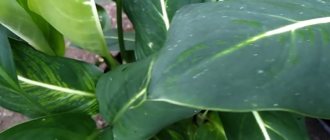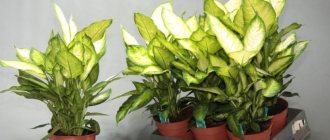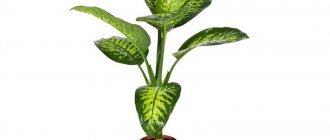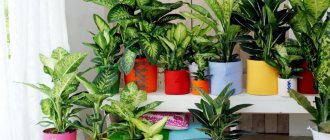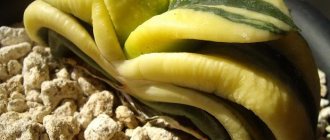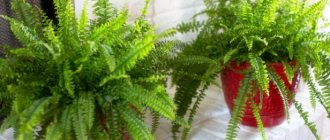A bright and attractive Dieffenbachia with luxurious striped leaves native to South America. The genus is named after the Austrian botanist Joseph Dieffenbach, who was head gardener at the Imperial Botanical Garden in Vienna in the 19th century.
All types of Dieffenbachia are evergreen plants from the Araceae family. In nature, they can grow up to 2 m, and can grow to the same size in an apartment. So you need a lot of space for this flower. The leaves are large, with spots and streaks, which gives them a special chic. But despite its beauty, Dieffenbachia can rarely be found in our apartments, because almost mystical powers are attributed to this plant. The chairman of the Moscow Flower Growers club, a collector of ornamental flowering plants, Tatyana Zhashkova, told us about the features of this plant
Types and varieties of Dieffenbachia
There are more than 60 species of Dieffenbachia in nature(1). But only a few of them are grown indoors.
Dieffenbachia seguine. In floriculture, it is better known under the old name Dieffenbachia maculata. This is one of the most popular species and the tallest - the plants reach a height of 2 m. The leaves are large, up to 50 cm long, with patterns of light specks.
There are many interesting varieties of this species.
- Green Magic - with deep green leaves with a cream vein in the center;
- Camille - it has white leaves with a green stripe along the edge;
- Compacta is a low-growing variety 50–65 cm high with light green leaves and dark green spots;
- Reflektor is a very bright variety with camouflage colored leaves: yellow and white spots are densely “scattered” on a dark green background;
- Rudolph Roehrs - with pistachio-colored leaves, a dark green stripe along the edge and a central vein of the same color, with white and green spots;
- Tropic Marianne - with cream-light green leaves with white veins and a thin dark green border;
- Tropic Sun - with light green leaves with a dark green border and central vein;
- Tropic Snow - with dark green leaves and numerous light stripes, streaks and spots;
- Tropical Tiki - with silvery leaves, on which numerous white spots are scattered, the border is dark green, and the central vein is light green.
Green Magic. Photo: YouTube
Camilla. Photo: YouTube
Reflector. Photo: YouTube
Tropical Tiki. Photo: YouTube
leopoldii . This species is native to Costa Rica. The plant is short, the trunk does not exceed 5 cm in height, but the leaves are long - up to 35 cm. They are dark green, with a white central vein. The petioles are short, about 15 cm, pale green with purple splashes.
Dieffenbachia oerstedii. Tall species up to 1.8 m high. Leaves up to 35 cm long, glossy, dark green, with a white vein in the center and sparse spots along it.
macrophylla . The species is native to Peru. The stem is up to 1 m high, the leaves are large, up to 60 cm long, rich green in color and have lighter veins. The juice has an unpleasant specific smell.
Dieffenbachia bausei. The plant is up to 90 cm high. The leaves are medium-sized, up to 30 cm long, oval, light green in color with a white marble pattern.
Dieffenbachia Estreda. Photo: YouTube
Dieffenbachia Bauze. Photo: YouTube
Origin of Dieffenbachia: biological portrait
Dieffenbachia belongs to the Araceae family. This is an ornamental evergreen plant, distinguished by large leaves with variegated colors and a lush crown of various shades. The homeland of flower culture is South America, therefore, like any tropical flora, it prefers high humidity. In conditions favorable for growth, Dieffenbachia reaches a height of 2 meters.
The subshrub got its name from the German botanist Dieffenbach, who invested a lot of effort in domesticating the wild crop. The plant blooms rarely, its buds resemble a spadix wrapped in a dull white bract. After the flowering process is complete, a cluster of red or orange berries develops in its place.
Under natural conditions, the life of a tropical plant lasts up to 10 years. For an indoor flower, this period is reduced by 2-3 times. At the same time, domestic Dieffenbachia often does not overcome the height threshold of 1 meter. In 4 years you can grow a lush shrub in an apartment. As the plant ages, it will lose its decorative appearance. Large leaves will fall off and the plant will become lethargic.
Caring for Dieffenbachia at home
Dieffenbachia is quickly becoming a favorite because it looks very impressive and is also extremely unpretentious. But some features of agricultural technology still need to be taken into account.
Priming
Dieffenbachias come from tropical forests, and there is a lot of organic matter in the soils there. Therefore, the soil for them must be fertile. Purchased soil is suitable for decorative foliage plants.
But it’s better to cook it yourself. The best option is a mixture of leaf soil, humus, peat and sand in a ratio of 3:1:1:1 (2).
Temperature
These plants do not have a pronounced dormant period, so they need to be grown in a warm place throughout the year. The optimal temperature is 20 – 25 °C; in winter it should not fall below 17 °C. Dieffenbachia does not tolerate drafts and temperature changes.
Lighting
Dieffenbachias do not tolerate bright sun, much less direct sunlight - they need shade. Moreover, they can easily be tolerated even with minimal lighting - they can be grown in the back of the room. However, in winter it is useful to place it on the windowsill (3) - at this time the sun is inactive and harmless, and away from the window it becomes too dark.
Humidity
The plant loves abundant watering (in spring and summer once every 2-3 days, in autumn and winter - once every 4-5 days), but does not tolerate excess moisture, so the pot definitely needs drainage.
Fertilizers and fertilizers
It is useful to feed Dieffenbachia once every 2 weeks from March to September - this is when they actively grow. It is best to use a complex liquid fertilizer. But it is important that it does not contain a lot of nitrogen (2) - it causes plants to grow very quickly.
Trimming
As Dieffenbachia grows, it often sheds its lower leaves, exposing the trunk - this is their natural feature. However, the plants lose their decorative properties. In order for the bushes to be lush, they need to cut off the tops once a year - then the dormant buds on the stems will wake up and new young shoots will appear.
Acclimatization and replanting after purchase
After purchase, Dieffenbachia must adapt to new conditions. To ensure successful acclimatization of the plant, it is recommended to adhere to the following rules:
- place the purchased plant in partial shade with a temperature of +18 °C;
- if Dieffenbachia was purchased in the winter, you should not immediately place it in a well-heated room, despite the fact that it is adapted to hot climates;
- if the soil in the pot is dry, abundant watering is necessary;
- After 40 minutes, pour out excess water from the pot.
Transplantation can be carried out only 10–14 days from the date of purchase. In this case, it is necessary to select a pot that matches the size of the plant’s root system. It is not recommended to replant the shrub into a large container to avoid waterlogging of the soil.
Dieffenbachia purchased in the autumn-winter period should be replanted from February to May.
Reproduction of Dieffenbachia at home
Photo: YouTube
Dieffenbachias reproduce well vegetatively and there are 2 methods that give excellent results.
Apical cuttings. In this case, cut off the top of the plant, tear off the lower leaves, if any, and plant the cuttings in a mixture of sand and sphagnum moss in equal proportions (2).
Stem pieces. It is better to root them in a mixture of sand and soil, also in equal proportions (2). Each piece should have 2–3 internodes. The stem sections are laid horizontally on the ground and covered with film or glass.
Both propagation options give best results in summer and late December. Cutting cuttings and pieces of stems is best combined with pruning the plant.
Propagation by stem pieces
Most of the planting material for propagating Dieffenbachia by cuttings is obtained from tall species - Motley (Dieffenbachia picta) or Charming (D. amoena). But Spotted Dieffenbachia (D. maculata) also has a variety called Camilla, which quickly reaches a height of two meters.
How to take cuttings
Pieces of the stem are cut off at right angles from above and below, making a cut between the nodes. The size can be anything, but it makes no sense to root long shoots without leaves - they will not make a beautiful plant.
It is better to cut the stem into 5-15 cm segments containing at least 2 internodes. If there are leaves on them, and rooting is going to be carried out in the substrate, the bottom one is torn off, the rest are twisted into a tube and secured with an elastic band. Be sure to mark the direction of growth on cuttings without leaves in order to plant correctly. Pieces of shoots that have any damage are thrown away.
If the base of Dieffenbachia continues to grow, blot the juice and treat the cut with activated carbon.
Planting material for propagation is washed under running water at room temperature until the juice stops flowing. Dry outdoors in a well-ventilated area for 3-4 hours to 24 hours. The time depends on the diameter of the stem - the larger, the longer.
It is not necessary to treat the lower cut with a stimulant during propagation - the crop produces roots well. But, if the owners are calmer, there will be no harm:
- when Dieffenbachia is about to be placed in water, the cuttings are soaked in a solution of root or heteroauxin for 3-5 hours;
- when planting in the substrate, the lower cut is dusted with a powdered stimulant.
It is useful to dip the cuttings in crushed activated or pure charcoal. Despite its great thickness, the stem of Dieffenbachia is herbaceous and therefore susceptible to rotting.
Rooting in water
Cuttings take root well in water. When propagating, it is not necessary to take a separate vessel for each; you can use a common container, so the short pieces will support each other in a vertical position. Some gardeners place the cuttings flat in a large bowl.
The first time crushed coal is added to the water at the rate of a tablespoon per 1 liter. The liquid is changed completely every 3-7 days, the more pieces of stems there are, the more often the container is rinsed. If the water becomes cloudy, pour it out immediately and inspect all the cuttings.
When the roots appear and reach 2-5 cm, Dieffenbachia is planted in light soil. The lower shoots of the crop are fragile; if they are longer than 5 cm, they will definitely break.
Rooting in the substrate
To propagate Dieffenbachia, take such a composition that when transplanting the cuttings into nutritious soil:
- there was no need to shake off the roots;
- com did not disintegrate.
One of the baking powders is mixed with neutral peat 1:1:
- perlite;
- sand;
- soaked coconut fiber;
- chopped sphagnum.
If there is a choice, preference is given to moss. It makes the substrate as porous as possible and protects the cuttings from rotting.
You can root pieces of Dieffenbachia stem:
- standing, immersing the lower internode in a mixture of peat and baking powder;
- lying down, pressing the cutting halfway into the substrate.
In the first case, if several sprouts appear, the bush will look like a dracaena with tufts. In the second, the rooted shoot will have to be cut into pieces, or several plants will have to be planted in a pot at once.
Care
Reproduction of Dieffenbachia should take place at a temperature of 20-22 ° C and high humidity. When rooted in water, the greenhouse effect is not needed. If cuttings without leaves are planted in a substrate, it is better (but not necessary) to cover the container with a transparent cap, especially when propagation takes place in autumn or winter.
The planting is ventilated daily. The substrate should be constantly moist, but not wet. From time to time the cuttings are sprayed.
Dieffenbachia diseases
Photo: YouTube
Problems with Dieffenbachia usually occur due to improper care.
The stem rots. This often happens if the plant is overwatered or the room is cool - the temperature is below 17 °C.
At the initial stage, when only part of the shoot is affected, the diseased tissue can be cut out with a sharp knife and the wound can be sprinkled with crushed charcoal. If the stem is severely rotten, you need to cut off and root the healthy top, and throw away the rest.
Leaves become pale. This happens if the plant is in too bright a room or if direct sunlight falls on it.
Move the Dieffenbachia to a darker place and the color of the leaves will soon be restored.
Young leaves fall. There are three reasons for this problem:
- temperature too low;
- dry air;
- drafts.
Move Dieffenbachia to a warm place and spray more often.
The edges of the leaves dry out. This occurs due to lack of watering - Dieffenbachias do not like it when the soil dries out; it should always be moist. The second possible reason is cold air.
Description of the plant
Dieffenbachia is a perennial evergreen plant of the araceae family, native to the American tropics. Dieffenbachia received its name in honor of the Viennese gardener Joseph Dieffenbach, and its discoverer was the Austrian botanist Heinrich Schott. Currently, about 50 varieties of the plant are known, but not all of them are used for indoor cultivation.
Dieffenbachia juice is poisonous; if ingested, it causes burns to the mucous membranes, swelling of the larynx, and upon contact with the skin of the hands, burning and irritation occurs. Considering this fact, the plant cannot be planted in an apartment with small children and animals, or it must be placed in a place inaccessible to them. Any maintenance work must be done with gloves and make sure that the juice does not get into your eyes when pruning.
There are many signs and beliefs associated with such a beautiful, but at the same time poisonous plant. They say that in a house where there is Dieffenbachia, no boys are born, men leave the family, lose their virility. The plant is popularly nicknamed “muzhegon”. However, not everyone pays attention to signs and superstitions, and live peacefully and happily with this spectacular plant in their home.
Dieffenbachia has significant positive properties - it is able to absorb harmful chemical compounds, formaldehyde, from the air. The large leaves of the plant release a lot of moisture and oxygen, attract dust, which improves the composition of the air. This is especially important in winter, when heating devices dry out the air and there is little oxygen in it.
It has been noticed that before rain, droplets of water appear at the ends of the leaves of the plant. Dieffenbachia is often placed in the kitchen, as well as in offices and in places inaccessible to children and animals.
The plant is loved by gardeners for its very beautiful, large, oval leaves of a dark green color with various light inclusions, spots, stripes and other patterns, depending on the variety. The leaves grow on a thick, succulent stem.
A Dieffenbachia flower appears extremely rarely when kept indoors; it looks like a cob wrapped in a thin cream-colored blanket. Dieffenbachia has a high growth rate; in 5 years the plant can reach a height of two meters.
Pests of Dieffenbachia
Dieffenbachia most often affects 2 types of pests.
Spider mite. The first signs are numerous small whitish dots on the leaves. With severe infection, the leaves begin to turn yellow and fall off, and cobwebs appear on the plant.
To destroy spider mites, you can use the drug Kleschevit (4).
Shield. It usually lives on stems and on the undersides of leaves. The insects are motionless and look like small brown tubercles. With severe damage, the growth of Dieffenbachia slows down greatly, its leaves begin to dry out and eventually the plant may die.
It is difficult to fight scale insects. The first step is to manually remove all insects using a cotton pad soaked in alcohol or vodka. And then carry out 2 - 3 treatments of the plant with Actellik (4).
Why can't Dieffenbachia be kept at home?
The juice of this plant is poisonous to people and animals. If it gets on the skin, it can cause serious burns. If the juice gets into the stomach, swelling of the larynx and tongue, blurred vision, interruptions in heart function, and anaphylactic shock may occur. Therefore, it is not recommended to keep diffebanchias in apartments where there are animals and small children.
In addition to the obvious harm from the poisonous juice, the reputation of Dieffenbachia is also spoiled by the superstitions associated with it. It is believed that in ancient times, the leaf of this plant could deprive a person of speech by sealing his mouth (which is completely understandable - the poisonous juice, causing swelling of the larynx and tongue, did not give the person the opportunity to speak).
But now there is a different opinion: Dieffenbachia is called “husband,” a symbol of celibacy. It is believed that this plant weakens male energy, which is why men cannot be in the same room with it. Therefore, it is not recommended for unmarried girls to have it. By weakening male energy, Dieffenbachia allegedly makes married couples infertile.
But, of course, this is nothing more than superstition.
Reproduction by shoot tips
The method is suitable for all types and varieties of Dieffenbachia. The top of the plant is cut off, and it can be any length, even half a meter. It is important to choose a container that is proportionate for rooting so that it is stable and does not tip over.
The base of the apex is freed from the lower leaves, prepared in the same way as stem cuttings, and rooted in water, a light or infertile substrate. Plant at a depth of no more than 5 cm; if necessary, tie it to a support so that the cutting does not turn out of the pot. After the roots appear, carefully move them into nutrient soil.
The main difference between propagation by apex and stem cuttings is that all leaves must be preserved. It is unlikely to be possible to cover the cut top of the Dieffenbachia so that the transparent cap does not touch the large plates. And if the leaves touch cellophane or glass that is wet from fumes, they will definitely begin to rot. So the humidity will have to be maintained in another way.
The cuttings need to be sprayed frequently, especially if they are rooting a large crown - the plant does not have lower shoots to supply the plates with water. Some of the vegetative organs may dry out. That is why cuttings with leaves are usually germinated in water before planting.
The simplest and fastest propagation of Dieffenbachia is from the top. The bushes immediately turn out beautiful - they do not need to awaken dormant buds or grow new leaves.
Popular questions and answers
Agronomist-breeder Svetlana Mikhailova told us about growing Dieffenbachia and the problems that may arise
How to choose Dieffenbachia?
Always pay attention to the appearance of the plant - there should be no stains, mechanical damage or signs of pests on the leaves. Inspect the shoots - it is important that they are not rotten.
Does Dieffenbachia bloom?
Yes, it blooms, but at home this does not happen often. And the flowers of Dieffenbachia are inconspicuous - a small cob surrounded by a green blanket.
Why do Dieffenbachia leaves turn yellow?
If the old lower leaves turn yellow and fall off, this is normal; this is a natural feature of Dieffenbachia. However, if young leaves turn yellow, then most likely the room is cool or the plant is in a draft.
Caring for You: Simple Tips
Dieffenbachia at home can not only grow, but also bloom, bear fruit and reproduce in various ways.
How to water Dieffenbachia? The main thing is not to over-moisten the soil. Dieffenbachia should be grown in flowerpots with good drainage and in soil of a special composition containing 1 part sand, two parts peat, two parts turf soil and 1 part humus. Carefully check the turf for the presence of insect larvae and worms, so that later you don’t have to look for the reason why the leaves are drying or whether the plant has a mysterious disease. For drainage, it is better to use expanded clay or broken brick.
One of the secrets of how to care for Dieffenbachia is the correct placement of the plant relative to the light source. When growing different varieties, we try to orient rich green plants closer to the window, variegated ones and with large white splashes - to shade them or place them in the far corner. Variegated varieties grown in bright light can easily lose their decorative properties.
Periodically, the leaves on the plants need to be wiped. It is recommended to use a damp cloth, and since the plant is poisonous, this procedure is best carried out with gloves. Dieffenbachia can be easily washed at home using a terry sock placed on your hand. We settle the water in a bucket (ideally, we take boiled or even distilled water, so as not to leave white stains on the leaf), rinse our hands in the bucket and evenly wipe the entire area of the leaf, without fear of getting the plant juice on the skin.
By the way, the benefits and harms of Dieffenbachia are the subject of debate among amateur florists: is it possible to keep a planted flower with a dubious reputation at home?
All tropical plants are poisonous to a greater or lesser extent. If Dieffenbachia juice fails to get on the skin, irritation in the form of redness may develop, and contact with the eyes can cause temporary blindness. Of course, Dieffenbachia should be kept away from small children. But it brings much more benefits than expected. It turns out that Dieffenbachia at home has a unique ability to purify the air from benzene and fromaldehyde, turning the atmosphere of a city apartment into the cleanest air of the Amazon.
With reasonable care, we can enjoy this majestic plant that turns our home into a green kingdom.
Sources
- Dieffenbachia // The Plant List (https://www.theplantlist.org/1.1/browse/A/Araceae/Dieffenbachia/)
- Visyashcheva L.V., Sokolova T.A. Industrial floriculture. Textbook for technical schools // M.: Agropromizdat, 1991 – 368 p.
- Dr. Hessayon D.G. All about indoor plants // M.: Kladez-Buks, 2002 – 256 p.
- State catalog of pesticides and agrochemicals approved for use on the territory of the Russian Federation as of July 6, 2022 // Ministry of Agriculture of the Russian Federation (https://mcx.gov.ru/ministry/departments/departament-rastenievodstva-mekhanizatsii-khimizatsii -i-zashchity-rasteniy/industry-information/info-gosudarstvennaya-usluga-po-gosudarstvennoy-registratsii-pestitsidov-i-agrokhimikatov/)
Dieffenbachia: poisonous to humans or not
How dracaena blooms - what types, proper care
The plant is considered toxic. To date, the exact composition of the poison has not been determined. However, the following active ingredients are known to be present in the flower juice: calcium oxalate, oxalic acid, saponins, proteolytic enzymes, cyanogenic glycosides, alkaloids and astringents. When working with Dieffenbachia: replanting, trimming leaves, wiping off dust, you need to take precautions. It cannot be said that the flower has a harmful effect on humans, but careless handling of it can lead to undesirable consequences - poisoning. If there are small children in the house, it is advisable not to purchase this flower.
Pruning Dieffenbachia
Harm of Dieffenbachia to humans
Touching the plant is dangerous - shooting cells open, from which juice with toxins is released. This may damage your skin and eyes. Skin irritation may occur if purple juice comes in contact with the skin. If the juice gets into the eyes, it burns the conjunctiva. If the poison is taken orally, symptoms such as burning, swelling and redness of the tongue and mucous membranes occur. Increased saliva production and swelling of the tongue make it difficult for affected people to swallow and speak. In the worst case, poisoning causes diarrhea, nausea, cardiac arrhythmia, paralysis and drowsiness.
Selection of conditions of detention
In order for the leaves to remain with a green rim, Dieffenbachia Camilla requires good lighting. Otherwise, they become almost monochromatic and faded. It should be borne in mind that too intense lighting will also harm the flower. It is best to place the pot on a stand or cabinet near a bright window (west or east) that does not open, because Dieffenbachia is afraid of drafts and immediately sheds its leaves.
If little light enters the room through the window in winter, additional lighting may be needed.
Dieffenbachia (photo) loves heat very much, so the room temperature should be at least 20 degrees Celsius. In winter, you should take special care of the comfortable maintenance of the plant, because a drop in air temperature below 15 degrees is detrimental to it, as well as sharp fluctuations.
Why prune and replant?
Like all Dieffenbachias, Camilla loses its lower leaves with age, so dry and limp foliage should be promptly removed. In addition, the flower grows quickly, and periodic pruning will help restrain its tendency to rise up and form a lush bush.
Pruning must be done with gloves, since the sap of the plant is poisonous.
A young growing flower must be replanted annually into a larger pot, while simultaneously changing the substrate to a fresh one.
